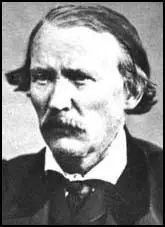Kit Carson

Christopher (Kit) Carson was born in Madison County, Kentucky, on 24th December, 1809. The family moved to Howard County, Missouri, when Carson was a child.
At the age of 14 Carson was apprenticed as a saddle maker in Franklin, Missouri. The following year he ran away and joined a group of people travelling to Sante Fe. Eventually he became a teamster for Robert McKnight at the Santa Rita copper mine in New Mexico.
He met Tom Fitzpatrick, the famous mountain man, and over the next few years he worked as a trapper in the Rocky Mountains. In 1835 Carson saved the life of Mark Head during a fight with a group of Blackfeet. The following year he joined the Hudson's Bay Company and in 1837 worked with James Bridger in the Yellowstone.
Carson's first wife died after giving birth to a couple of children. His second wife was a Native American. Later he married Marie Josefa Jaramillo. Carson took his eldest daughter to school in Missouri. On the journey he met John Fremont, who had just surveyed the Des Moines River. The two men got on well and Fremont hired him as a guide at £100 a month.
In 1843, with Carson and Tom Fitzpatrick as his guides, Fremont's party followed the Cache de la Poudre River into the Laramie Mountains. He then crossed the Rocky Mountains via the South Pass and Green River. He then followed the Bear River until it reached the Great Salt Lake.
After spending time at Fort Hall he followed the Snake River past Fort Boise to Fort Vancouver, where he met John McLoughlin. Fremont then turned south where he explored Klamath Lake and the Great Basin before making a midwinter crossing of the Sierra Nevada mountains and despite great hardships reached Sutter Fort. Fremont and Carson eventually reached St. Louis on 6th August, 1844.
In 1845 Carson joined John Fremont at Bent's Fort for his third expedition. While this trip was taking place the Mexican War started. Fremont was given the rank of major in the United States Army and General Stephen Kearny persuaded Carson to work as his guide in his attempts to capture California.
Carson developed a sympathy for the plight of Native Americans and in March, 1854, he became an Indian agent in Taos. On the outbreak of the American Civil War Carson joined the Union Army. He was given the rank of colonel and commanded the 1st New Mexico Volunteers.
In 1849 Carson began farming at Raydo, New Mexico. He often left the farm to guide military parties. Carson also went trapping in the mountains and took sheep to California.
Carson was appointed superintendent of Indian Affairs for Colorado Territory in 1853. He held the post until 1861 when he resigned to become a colonel in the New Mexico Volunteer Infantry. After taking part in the battle of Valverde, he was promoted to Brigadier General. He led an expedition to Adobe Walls and in November 1864 he fought about 3,000 Kiowas, Comanches, and Arapahoes.
Kit Carson resigned from the army in November, 1867. He settled at Boggsville, Colorado, where he died on 23rd May, 1868.
Primary Sources
(1) John C. Fremont, Exploring Expedition to the Rocky Mountains (1845)
In the afternoon a war-whoop was heard, such as Indians make when returning from a victorious enterprise; and soon Carson and Godey appeared, driving before them a band of horses, recognized by Fuentes as part of those they had lost. Two bloody scalps, dangling from the end of Godey's gun, announced that they had overtaken the Indians as well as the horses... The time, place, object, and numbers considered, this expedition of Carson and Godey may be considered among the boldest and most disinterested which the annals of western adventure, so full of daring deeds, can present. Two men, in a savage desert, pursue day and night an unknown body of Indians into the denies of an unknown mountain - attack them on sight, without counting numbers - and defeat them in an instant - and for what? To punish the robbers of the desert, and to avenge the wrongs of Mexicans whom they did not know. I repeat: it was Carson and Godey who did this - the former an American, born in Boonslick County in Missouri; the latter a Frenchman, born in St. Louis - and both trained in western enterprise from early life.
(2) John F. Rusling, Across America (1874)
He (Kit Carson) declared that all our Indian troubles were caused originally by bad white men... He pleaded for the Indians as "poor ignorant creatures" whom we were daily dispoiling of their hunting grounds and homes.
(3) Charles Averill, Kit Carson (1849)
I have heard that of his character, which leads me to believe that the rough manner, the uncultivated speech, apparently peculiar to him, are in a degree assumed; that he in his youth received the benefits of a good education and good society, but that he ever loved the wild delights of a hunter's life, and with its freedoms and pleasures, determined to adopt its plain habits and plainer mode of speech.
(4) Hubert Howe Bancroft, History of California (1886)
Somewhat less garrulous and boastful than many of the frontiersmen; yet the difference between him and others of his class in character and skill was by no means so marked as has been represented in eulogistic biographical sketches. No one, however, begrudged Kit the fame his biographers have given him. It is their custom, ignoring faults, to concentrate in one trapper all the virtues of his class for dramatic effect.

